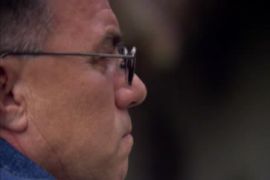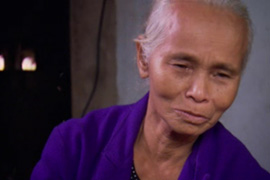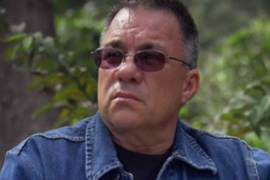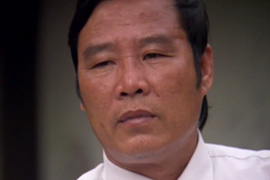Revisiting the My Lai massacre
Forty years on, a former US soldier present at the massacre returns to Vietnam.

Pham Thi Tuan says she lay motionless among dead bodies for hours in the ditch where she and her baby daughter had been herded with more than 100 other people.
It was only the corpse of her father that prevented her from being killed on March 16, 1968 in what gained universal notoriety as the My Lai massacre.
Now 75, Pham is one of the few remaining survivors of the atrocities that saw US soldiers from Charlie Company chopper in to the tiny hamlet in central Vietnam and spend the next four hours killing and maiming up to 500 innocent Vietnamese, many of them women and children.
 |
| Pham says she cannot forget the events of March 16, 1968 |
More than 40 years on the memories are still painful.
“They ordered all of the families to sit or stand in the ditch. Then they shot,” she says. “After five minutes they shot the second time. If they heard weeping they shot a third time.
“I cannot forget it as long as I live. I even remember the shooting of my people in the ditch in my dreams.”
The hard facts of the massacre are well established through gruesome photographic evidence. When news of the killing emerged more than a year later 26 members of Charlie Company were arrested and many charged with murder.
Only William Calley was convicted and he served just four and a half months of his prison sentence.
But although the ‘what’ of My Lai is now known the reasons why such a crime could be committed against civilians are not and as the 40th anniversary of the killings passed, rampages such as Haditha in Iraq mean old wounds are being reopened and old questions asked once more.
Public conscience
Pham Thanh Cong has dedicated his life to making sure the memories of the massacre remain in the public conscience.
He was 11 at the time and still bears a deep furrow from a bullet that nearly killed him. He is now in charge of the museum dedicated to the victims of the massacre and the caretaker of what remains of where they lived.
As he showed Al Jazeera around the bunker where he sheltered for hours while members of his family lay dying, Cong described what he would say to a member of Charlie Company.
“I would ask him a question. Why he would kill ordinary people – women and children and women with babies in their bellies?”
While uttering these words Cong was unaware that he was shortly to get the opportunity to ask that question.
Returning to the scene
No member of Charlie Company has returned to the scene of the massacre before, but 40 years after being charged with killing nine Vietnamese villagers Ken Schiel has returned to My Lai.
Only 19 at the time, Schiel says he still cherishes the faded photographs of the day he joined the army but has trouble recognising the village and scene of the atrocities.
It had been a dispiriting couple of months for the US in Vietnam prior to My Lai. The Tet offensive had surprised a military that thought it was winning the war.
For Charlie Company the losses had been personal – they had lost a third of their comrades on the day before March 16.
That morning helicopter machine guns laid down suppressing ire and three platoons fanned out across the rice paddies and into the hamlets that collectively made up My Lai.
‘Following orders’
Their orders were to kill everything that moved and they met little resistance.
 |
| Ken Schiel returned to the scene of the massacre |
It is unclear whether the soldiers’ consciences were clouded by revenge or if they were motivated by a military command that measured success by body counts or if it was a mentality that all Vietnamese were merely enemies, an embodiment of communism.
“Before we came to Vietnam you almost did not even think of Vietnamese as people,” Schiel says.
“I was a soldier following orders. And I believe that’s how I dealt with that then. And that’s how I deal with it today,” Schiel says as he tours the museum in My Lai.
He says he is mystified by the granite wall of dead inside, claiming he did not remember that many people in the village but admits that everyone was unarmed.
“Did I shoot? I’ll say that I shot until I realised what was wrong … I’m not going say whether I shot villagers or not.”
However in a sworn statement during the My Lai investigation another soldier recalls seeing Schiel firing at villagers while saying, “I don’t want to shoot them but I have to because we were ordered to”.
‘Cannot forget’
When Cong and Schiel meet neither man is aware of the others past.
“I was part of the Americans that landed here in the helicopters. And I want to apologise to the people of My Lai,” Schiel says. “I ask myself all the time, why did this happen. I don’t know.”
“A sad feeling and an angry feeling are rising up in my heart. The US soldiers killed my mother, my older sister and my younger brother,” Cong replies.
“How did you feel when you shot into civilians and killed? Was it hard for you?”
“The only thing I can do now is just apologise for it,” Ken says, denying he knows if he killed anyone.
.
Such ignorance is hard for Cong to take as it emerges that Schiel was present at the edge of the village where his family were killed.
“So maybe you came to my house and killed my relatives,” he says and the gutwrenching possibility makes it hard for him to look at Schiel.
“In Vietnam we have the tradition that we let bygones be bygones, but in our hearts, we cannot forget …. You should educate your younger generations, your children, not to do it again. And not to make war anywhere in the world.”
“Well those are fine words. I would stop war today if it was possible,” Schiel responds. “Now that I’m older I can see this. But when I came to Vietnam I was very young. I’ve never acknowledged, to any great extent, that I was at My Lai.
“But I’m here to tell you what was done here was wrong. I can’t justify what happened. I can’t fix your heart. I can’t bring your people back to life. And I’m sorry.”
Set the record straight
Both men are visibly shaken by the encounter and Schiel admits that he has been hiding things from himself, sheltering behind the claim he was only following orders.
“I mean, I have the memories. But I have to protect my feelings. I have to protect myself.”
Some of Schiel’s comrades have not survived self-examination of their role in the massacre. Venardo Simpson committed suicide in 1997.
 |
| Cong lost his mother, sister and brother in the massacre |
A day after meeting Schiel, Cong says he spent a difficult night and visited the graves of his relatives.
He says he could not bring himself to strike or beat Schiel because it is against the laws of Vietnam.
According to Gary Myers, a lawyer who represented one of the soldiers involved in the My Lai massacre and who has also been involved in the investigations into the Haditha and Abu Ghraib incidents during the war in Iraq, Schiel’s claim that he only followed orders does not stand up.
“There is no legal order that allows you to blast an 18-month-old child out of a trench. That’s an illegal order. And you have the duty not to obey that order,” he says.
“As a lawyer I can tell you that the people I’ve represented in both settings were perfectly decent people. This is not about sociopaths.
“Some would say that it’s a lack of character. I don’t believe it’s a lack of character. I believe that it is a simple truth, that war is a horrible, horrible thing.”
Ken Schiel says he came back to My Lai to set the record straight about his platoon and that although he was full of sorrow he was not going to break down and cry.
However, as Al Jazeera leaves him, Schiel does finally break down and cry, and a Vietnamese translator, who lost a brother in the war, gives him a hug.
Click here to learn more about Josh Rushing’s On War series